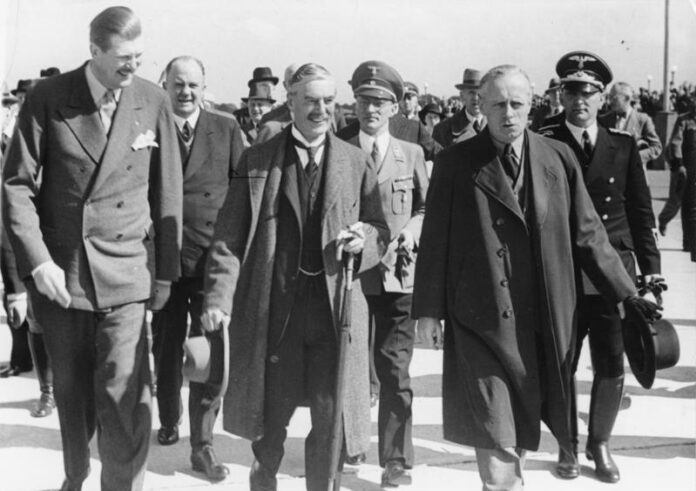This article has been written by Ishani Samajpati, pursuing B.A. LL.B. (Hons) under the University of Calcutta. The article offers a detailed discussion and explores the legal perspectives and backgrounds of the historically significant Munich Agreement in 1938.
It has been published by Rachit Garg.
Introduction
“I believe it is peace for our time.”
That was what British Prime Minister Neville Chamberlain boldly stated before the Press in London while returning from Germany after signing the Munich Agreement on 30th September 1938.
The Munich Agreement was a treaty between four countries namely Germany, Great Britain, France, and Italy. The settlements reached in the Munich Agreement are considered to be one of the crucial moments in 20th Century history. The said Agreement has also been a source of multiple speculations by historians, diplomats, advocates, peace brokers and experts across the world. While some see the Munich Agreement as a desperate attempt to broker peace in disturbing times, just before the onset of the deadly World War II, others simply see it as appeasement failing to deter one of the bloodiest wars in history.
The article attempts to analyse the legal -perspectives as well as a critical discussion of the historical events that shaped the finalisation of the Munich Agreement.
What is Munich Agreement
The Munich Agreement was a pact resulting from the settlements reached by Neville Chamberlain of Great Britain, Adolf Hitler of Germany, Edouard Daladier of France, and Benito Mussolini of Italy on 30th September 1938.
The Agreement dealt with the annexation of Sudetenland, a region dominated by ethnic Germans in western Czechoslovakia with Germany.
Background of the Munich Agreement
The Munich Agreement was concluded and signed during 29-30th September, 1938. There have been several factors which gave rise to the need for the Agreement. The crises that gave rise to the need for the Agreement started immediately after World War I and the urgency increased with the rise of Hitler and his expansionist foreign policy of the Third Reich.
The Sudetenland crisis
Czechoslovakia declared its independence on October 28, 1918, after the Austro-Hungarian Empire collapsed during World War I. Within the newly-formed state, most residents were Czechs and Slovaks but there was a significant number of ethnic German people, roughly three million. The majority of them resided in the Sudetenland.
Most of the Sudeten Germans heavily opposed the Czechoslovakian government and its policies. They wanted to join either Austria or Germany because of the anti-German sentiment in the new government and their apparent preferences for Czechs or Slovaks.
In the coming years, some development was made for the Sudeten Germans but they remained underrepresented in the government and the Army. The Great Depression heavily affected the highly industrialised Sudeten Germans and a large number of unemployed persons in Czechoslovakia were Sudeten Germans.

Rise of Hitler in Germany
During this ongoing crisis, the National Socialist Party in Germany had come to power. As part of his foreign policy, Hitler decided to unite all the German-speaking people into one Collective Reich, justifying his expansionist policy. He planned to reunite Germany with Austria and the Sudetenland.
Demand for autonomy
In 1933, Konrad Henlein founded the Sudeten German Party in Czechoslovakia and quickly became one of the most prominent political parties, with the support of the ethnic German residents.
In the following years, the Party received financial and diplomatic support from the Nazis. Encouraged by the support of German minorities, Sudetenland began demanding its autonomy from Czechoslovakia, claiming oppression by the government.
In 1938, after the annexation of the Federal State of Austria (Anschluss) in March 1938, Hitler concentrated on annexing Sudetenland and grew increasingly hostile to Czechoslovakia.
Role of Britain and France
After World War I, neither Britain nor France was prepared to defend Czechoslovakia. Chamberlain, the British prime minister, centred on a peacemaking policy which involved giving military, political and territorial concessions to Germany in order to prevent an upcoming war.
Both the French prime minister Édouard Daladier and Chamberlain believed that peace could only be maintained if the Sudetenland was handed over to Germany.
Requirement for the Munich Agreement
Chamberlain, the British Prime Minister, wanted to stop an impending war and tried to satisfy Germany with the Munich Agreement by allowing the annexation of Sudetenland to Germany. Adolf Hitler’s rise to power and remilitarisation of Germany served as the main requirement of the Munich Agreement.
Adolf Hitler was elected the Chancellor of Germany in 1933 and became determined to reclaim lost German territories. Sudetenland was a region in neighbouring Czechoslovakia bordering Germany and was home to many Germans. The Czech government was against annexing the region with Germany. But the British and French governments wanted to avoid war and adopted a policy of peacemaking.
Negotiations for Munich Agreement
Neville Chamberlain, the British Prime Minister at the time, took the initiative to address the crisis and scheduled three successive meetings with Hitler. The first meeting was on 13th September, 1938 at Hitler’s vacation residence at Berchtesgaden. The second meeting took place in Bad Godesberg on 24th September, 1938 resulting in the Godesberg Memorandum demanding that Czechoslovakia give up Sudetenland to Germany by 28th September, failing which Hitler threatened to take the territories by force.
Without consulting the Czechoslovakian government, Chamberlain agreed to Hitler’s demand. He also convinced Benito Mussolini, the leader of Italy, along with the French and Czech governments to enter the negotiations. The final meeting took place between Britain, France, Germany and Italy on 29th September in Munich and reached a final resolution in the absence of the Czech government. Chamberlain, Hitler, Mussolini and French Prime Minister Édouard Daladier signed the Munich Agreement on 30th September agreeing to the German annexation of Sudetenland on the condition Hitler would stop the mobilisation of military forces to reclaim the territories.
Czechoslovakia was forced to accept the conditions because it was impossible for them to fight the Nazi armies without the support of Britain and France. On 1st October, 1938, German troops moved into Sudetenland.
However, the appeal for peace was not long-lasting. On 1st September, 1939, Germany invaded Poland, violating one of the main conditions of the Agreement.
Conditions in the Munich Agreement
The Munich Agreement, concluded and signed between September 29-30, 1938, stipulated the following conditions:
Germany, Great Britain, Italy and France were in agreement with the annexation of Sudetenland with the condition that Germany will stop its military mobilisation in the neighbouring areas.
Evacuation of territory
The Agreement mentioned that the evacuation of the territory would begin on 1st October and should be completed by 10th October.
The Czechoslovak government was given the duties and responsibilities of carrying out the evacuations without causing any damage to any existing installations. An international commission comprising the representatives of Germany, the United Kingdom, France, Italy and Czechoslovakia laid down the conditions for evacuation.
Territorial occupation by Germany
The predominantly German territories would be occupied by the German troops from 1st October.
In the map, the territories were marked as No. I, No. II, No. III and No. IV and were said to be occupied by the German troops in the following manner:
- The territory marked No. I on the 1st and 2nd of October, 1938;
- the territory marked No. II on the 2nd and 3rd of October, 1938;
- the territory marked No. III on the 3rd, 4th and 5th of October, 1938;
- the territory marked No. IV on the 6th and 7th of October, 1938.
The remaining territory would be occupied by the German troops by 10th October after being ascertained by the international commission comprising the representatives of Germany, the United Kingdom, France, Italy and Czechoslovakia.
Plebiscite
The mentioned international commission would determine the territories where a plebiscite would be held, similar to the Saar plebiscite at the end of November. Before the completion of the plebiscite, the territory would be occupied by the international commission.
Final determination of the frontiers
The mentioned international commission shall determine the final frontiers. The Commission would also recommend minor modifications of the regions which were transferred without a plebiscite to Germany, the United Kingdom, France and Italy in exceptional cases.
Transfer of population in the territory
A transfer right, mentioned in the Agreement as the “right of option into and out of the transferred territories” was given to exercise within six months from the date of signing of the Munich Agreement.
The details of the option of transferring the population and other rights were given to a German-Czechoslovak commission to determine and settle disputes arising from the transfer.
Releasing of Sudeten German nationals
The final condition in the Agreement was that the Czechoslovak government should release all the Sudeten Germans who were working in the police or in the army within a period of four weeks.
Apart from that, all the Sudeten German political prisoners should be released during the same time period.
Munich Pact
An annexure to the agreement was signed respectively by the four aforementioned signatories known as Munich Pact.
It stated that the French and British governments would provide an international guarantee to the state of Czechoslovakia against any “unprovoked aggression”.
Germany and Italy also signed the same Pact, but the two countries agreed to give guarantees after the official settlement of the question regarding the Polish and Hungarian minorities in Czechoslovakia by the government.
Legal perspectives of the Munich Agreement
All the four parties to the Agreement and the neighbouring countries including Poland, Hungary, Romania, Yugoslavia and the Soviet Union as well as the United States of America had certain legal obligations. Customary international law prohibited nations from intervening except in matters of defence.
Obligations under the Paris Pact and the First Hague Convention
All the mentioned countries were parties to the Pact of Paris, 1928. The Pact renounced war as a national instrument. If any signatory power resorted to war, the party would be immediately denied the benefits offered by it.
The First Hague Convention, 1899 also condemned the war. Under this Convention, the parties were legally obliged to seek an alternative peaceful means of settling the disputes.
Provisions under the Covenant of the League of Nations
Under Article 10 of the Covenant of the League of Nations, 1919, State parties were required to deter themselves from external aggression regarding territorial jurisdiction. Similarly, under Article 12, they were required to inform the League of any disputes for arbitration or judicial settlement and were not supposed to “resort to war until three months” after that. However, all the mentioned nations except Germany and the United States were parties to the Covenant. Hence, Germany was not bound by any international legal instruments not to claim territorial jurisdictions.
However, some significant conditions of the Covenant were violated by the parties. According to Article 11 of the Covenant, “any war or threat of war” concerning both member states or non-member states was to be declared a matter of concern for the League. The League was the sole authority to take the final decision to maintain peace internationally. Article 11 also contained provisions calling emergency meetings by the Secretary-General at the request of any member state in matters of urgency. However, the Munich Agreement was the result of internal meetings and private visits, mainly between Hitler and Chamberlain.
The Covenant also included provisions in Article 16 to assist a state with defence forces in the event of an unavoidable war.
Article 17 contained provisions regarding disputes in the case of a member state and a non-member state. If one of the parties, member or non-member, refused to accept the obligations in the event of a dispute, the Council was authorised to take appropriate measures and make recommendations to prevent hostilities.
Under Article 19, the Assembly was empowered to advise the member states regarding international situations that might hamper international peace.
However, while signing the Munich Agreement, the League of Nations was not even informed. It appeared to be a hurried approach to satisfy and appease the expansionist mentality of Hitler.
Bounding treaties of Czechoslovakia
Czechoslovakia was bound by a number of international treaties to accept the supervision of the League of Nations in any disputes and to respect minority rights under Article 57 of the Treaty of St Germain, Minorities Treaty, September 10, 1919 and the Council Resolution on November 29, 1920. However, it is also an accepted fact that the ethnic minorities, mainly Sudeten Germans, were greatly discriminated against, which gave rise to the demand for a separate territory of Sudetenland. As for the supervision, the League of Nations had no opportunity to mediate the dispute since none of the signatories was involved in the dispute. Hence, the League of Nations did not get a chance to help Czechoslovakia retain its jurisdiction.
Violation of the Locarno Treaties, 1925
The Munich Agreement was a direct violation of the Locarno Treaties, 1925. Under this treaty, all disputes between Germany and Czechoslovakia were subject to settlement under the jurisdiction of the Permanent Court of International Justice. The Locarno Treaty was legally binding on Germany when the Munich Agreement was signed. Hence, the Munich Agreement was legally void. But the appeasement of Germany by other nations was not only shocking but lawfully unacceptable.
Violation of alliances of aid and assistance by France
Czechoslovakia had alliances with France under the French-Czechoslovakia Treaty at Locarno to lend immediate aid and assistance if Czechoslovakia was the victim of any attacks. However, instead of providing any assistance as promised, France became a signatory to the Munich Agreement. To Czechoslovakia, this Agreement became a symbol of betrayal.
Legal nullification of the agreement
Neville Chamberlain, despite his attempts to appease Hitler to broker peace, failed and was forced to resign. His successor, Winston Churchill, who opposed the Agreement from the beginning, promised to return the Sudetenland to Czechoslovakia after the War.
On 5 August 1942, the British foreign ministry officially sent a note to Czechoslovakia regarding the return of the territory.
The French government also held the Munich Agreement null and void in 1944. After replacing Mussolini, the Italian government did the same.
Following the defeat of Germany in World War II, Sudetenland was returned to Czechoslovakia. The German-speaking majority was expelled due to their earlier support of Germany.
Criticisms of the Munich Agreement

Winston Churchill, one of the greatest opposers of the Agreement famously remarked that the Munich Agreement was a choice between war and dishonour and described it as ‘an unmitigated disaster’.
The main criticism of the Munich Agreement was that Czechoslovakia, the country in question where the disputed region of Sudetenland was situated, was never consulted in any of the diplomatic meetings. The Czechoslovakian government was just merely informed of the decision and was forced to accept it. Apart from that, there have been several direct violations of the other Treaties and Conventions that were in force during the period.
The main intention behind signing the Agreement was to prevent an immediate war by brokering peace. While that intention was completely a failure, the Agreement became synonymous with appeasement of expansionism by a totalitarian state like Nazi Germany and a betrayal of the nation of Czechoslovakia by the rest of Europe.
Conclusion
The Munich Agreement became one of the most criticised diplomatic agreements in world history ever since. In 1938, to avoid war, British Prime Minister Neville Chamberlain rushed to Germany in September to talk with Hitler for peace. Without consulting with Czechoslovakian leaders, he agreed to Hitler’s demand, a decision that was ultimately finalised when Germany, Britain, France, and Italy signed the Munich Agreement on September 30. It ultimately resulted in handing over the Sudetenland region to Germany through the Munich Agreement.
Chamberlain returned from Munich proclaiming that he had achieved “peace for our time.” He was proved wrong when within eleven months, German troops invaded Poland and marked the beginning of World War II in September, 1939.
The Munich Agreement also taught the lesson that appeasing an adversary’s demand may delay an upcoming crisis, but it is not the ultimate solution.
Frequently asked questions (FAQs) on Munich Agreement
Why was the Munich Agreement necessary?
The Munich Agreement was considered necessary to broker peace and stop another impending war after World War I. With its failure to stop the expansionist policy of Germany, it is now termed as an appeasement and betrayal to the nation of Czechoslovakia.
References
- https://www.mzv.cz/file/198473/MunichAgreement.pdf
- https://www.upn.gov.sk/data/files/skladacky-2017-23_24.pdf
- edouard daladier and munich: the french role in an international tragedy
- https://www.thetimes.co.uk/article/we-have-learnt-the-wrong-lessons-from-munich-9sfsjghfmxr
- https://www.forbes.com/sites/timreuter/2015/05/08/the-munich-agreement-did-not-cause-world-war-ii-the-nazi-soviet-nonaggression-pact-did/?sh=1ca493cf44c7
- https://www.washingtonpost.com/news/worldviews/wp/2015/07/20/in-defense-of-neville-chamberlain-hindsights-most-battered-punching-bag/
- The Munich Settlement and International Law Quincy Wright, The American Journal of International Law, Vol. 33, No. 1 (Jan., 1939), pp. 12-32 (21 pages), Published By: Cambridge University Press, available at: https://www.jstor.org/stable/2190836
Students of Lawsikho courses regularly produce writing assignments and work on practical exercises as a part of their coursework and develop themselves in real-life practical skills.
LawSikho has created a telegram group for exchanging legal knowledge, referrals, and various opportunities. You can click on this link and join:
Follow us on Instagram and subscribe to our YouTube channel for more amazing legal content.






